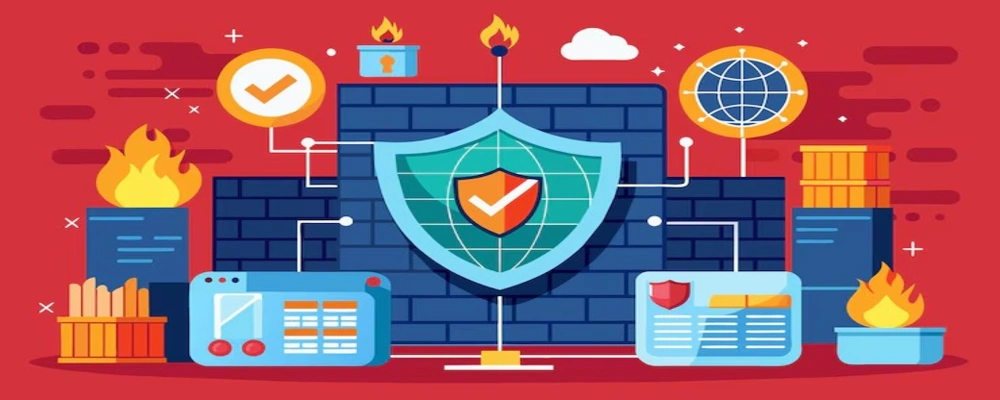Description
What does next next-generation firewall mean?
In other words, Next Generation Firewalls are network devices designed to shield one's computer from threats such as viruses and attacks that continue today and into the future. They could either be hardware or software-based. Application-level, port-level, and protocol-level security policies enforce the application of security in an organization against anything aside from an attack.
Some of the advanced features of the NGFW include:
- NGFWs work in many different areas of the OSI model, thereby taking a more holistic approach to security. The following security functionalities are incorporated:
- DPI (Deep Packet Inspection): For NGFWs, packets that traverse the network are analyzed and examined for malicious payload content or application behavior.
- IPS: Monitors network traffic for any suspected activity and automatically takes measures to either block a potential threat or notify the administrators.
- Application Awareness: NGFWs provide identification as well as control over applications operating within the network, offering organizations the ability to apply policy enforcement based on application behavior rather than just IP address.
- User Identity Awareness: Integrated with directory services, NGFWs can enforce security policies based on the user identity to give fine-grained access control over who can access which resources.
- Advanced Threat Protection: Often, NGFWs integrate state-of-the-art functions such as sandboxing and threat intelligence to detect and react to advanced threats in real-time.
Most Next Generation Firewalls consider at least three types of capabilities: enterprise firewall capabilities, IPS, and application control.
NGFW does exactly that; it saves you from traditional stateful inspection of firewalls. It gives a lot of context to your decisions by understanding what stage the traffic would be running through your system for web applications and effectively closing any avenue through which a potential vulnerability could be exploited by malicious users.
Benefits of next-generation firewalls
There are unique benefits brought about by the combination of different features of next-generation firewalls to users. It is not possible with older firewalls that NGFW is able to take action by blocking most malware even before getting to enter the network.
- Integrating these with threat intelligence services allows NGFWs to better enable detection of advanced persistent threats (APTs). Use of application awareness, discovery services, protection systems, and awareness tools is also affordable for those organizations that wish to install NGFWs as a basic device to improve their device security.
- Next-generation firewall versus traditional firewall
The two different types of firewalls, NGFW and Traditional firewalls, are meant to secure an organization from various threats and operate on similar presumptions.
- The common ground for both types of firewalls would be the static packet filtering meant to filter packets right at the point of interface to network traffic. In addition, both perform stateful packet inspection, network and port address translations, and can also set up VPN connections.
- One of these differences is that traditional firewalls do not go to the same extent as deep-packet inspection; they only offer the facility of port and protocol inspection. Other major distinctions between the two types of firewalls include application-level inspection, intrusion prevention, and the ability to act on data provided by threat intelligence services.
- NGFWs, therefore, extend traditional firewall functionality NAT, PAT, and VPN support, to operate both in routed mode - the firewall behaves as a router - and seamless mode - the firewall behaves like a bump in the wire when it scans packets in the new threat management technologies.
Instating NGFW into Your Organization
1. Evaluating Your Security Requirements
Before being turned into an NGFW, organizations should assess their security needs and determine the potential points of vulnerability. This assessment will outline the features and capabilities that will be required to address specific security issues.
2. Make to the Point: NGFW and Its Selection
Many NGFW solutions are now available in the market, each of which has its own unique set of features and capabilities. Most organizations should evaluate the various alternatives based on their requirements, budgets, and scalability needs. Hence, other factors such as management, integrations, and cloud environment support-for instance, AWS-would also be considered.
3. Deploying the Plan
Once the selected NGFW has been finalized, organizations should have an action plan for the project. It should take into consideration the network architecture and existing security solutions that will need to connect with the systems, as well as user training. With all these in mind, the deployment will become smooth with little disruption to business.
4. Continuous Monitoring and Optimization
Organizations should continuously monitor NGFW performance after installation and optimize it whenever necessary. They should adopt a regular review of security policies, analyze traffic patterns, and keep informed about new threats to maintain an efficient security posture. To keep the NGFW working properly while adjusting to changes in security challenges, organizations will also have to undergo periodic audits.
Conclusion
NGFWs are a huge technological stride in network security for an organization to cope with current cyber threats.. Bringing some more advanced features, NGFWs integrate deep packet inspection, control applications, and real-time threat intelligence to bring better security and ease of management. The adoption of cloud and various facets of AWS by organizations makes it all the more relevant to adopt strong next-generation firewall security. Deploying NGFWs allows sensitive data to be protected and also optimizes network performance for lower operating costs. The need for investing in NGFW technology is indispensable for any company intending to secure its digital assets and attain sustained success in a world where cyber threats evolve every second.


